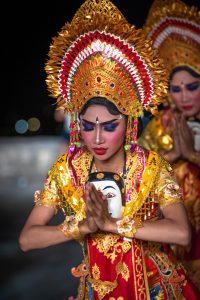46 SE Asia: Cultural Geography II – Bali
The Indonesian island Bali is a distinctive place, unusual among the many thousands of islands in that country. Created through geologic subduction, the island features several volcanoes, including the active Mount Agung, rising over ten thousand feet. Let’s consider a few aspects of Bali.
1 – Given the diminutive size of this island, Bali has outsized importance in culture and tourism. There are thousands of small Indonesian islands that are trivial in population or socioeconomic features; however, even at its size, Bali is very important. The large islands or island territories of Sumatra, Kalimantan (on Borneo), Java, Celebes, and Irian Jaya (on New Guinea) dwarf Bali. Even the tiny former Indonesian property but now country East Timor is larger than Bali.
The island Bali plus several even smaller islands make up the province of Bali, an administrative region of Indonesia. Bali is the third smallest province in the country, only larget than the Capital Special Region of Jakarta (the national capital region, like Washington, DC) and the Special Region of Yogyakarta (a unique historical sultanate). At 5780 km2, Bali is about the size of Delaware.
2 – Bali is Hindu, amidst a sea of Muslim islands. Indonesia has the largest Muslim population in the world at about 231 million adherents, edging out Pakistan (212 million) for first place. (This is a surprise to many people, who think of the Middle East as the core of the Islamic faith. The Middle East is the core, but is not a densely populated region. Iran’s 82 million Muslims ranks only 8th in the world.) While most of the geographic diffusion of Islam was accomplished over land, Indonesia is unusual in that Islam arrived by sea. Of course, with Indonesia being an island country, this was essential.

Officially, the government lists this faith as Agama Hindu Dharma. In 1952, the government of Indonesia decreed that an official Indonesian religion must be monotheistic. Hinduism, as primarily in India, usually features multiple deities, but has a variety of traditions and approaches, so the Balinese monotheistic approach is acceptable and was necessary for government recognition in Indonesia.
Hinduism also arrived in the Indonesian islands by sea, obviously. History recorded evidence of Hindu presence in the first century CE. Hinduism grew over the years, but about 1400 CE there began years of attacks from Muslim armies. This limited the Hindu practice until the European colonial arrival. As Indonesia islands became dominated by the Dutch, religious expression was tolerated and Bali remained Hindu.
3 – Bali is a portion of the Coral Triangle. The roughly triangular region of islands and adjacent seas contains three-quarters of the world’s shallow-water reef-building coral species, while having less than 2% of the world’s ocean area. The Coral Triangle is vital to the region’s economy and its seafood is an essential core of the triangle’s population’s diet. The southwestern corner of the Coral Triangle Initiative tracks through the waters immediately west of Bali. This organization spurred by Indonesia includes five other countries – Malaysia, East Timor, Papua New Guinea, Solomon Islands, and the Philippines.

4 – The eastern coast of Bali abuts the Lombok Strait, named for the cross-strait Lombok Island.
This strait has three important features.
a – It is part of the Wallace Line that marks the separation of Southeast Asian fauna from Australian fauna. The animal species (fauna) of Australia and nearby islands differ markedly from animal species of Southeast Asian islands.
b – Although the distance between Bali and Lombok is only about 22 miles (thus a strait), the water is relatively deep compared to other passages. It is likely that the depth of the water inhibited or prohibited the movement of animals between Bali and Lombok, thus making it part of the separation marked by the Wallace Line.
Additionally, the deeper water has a modern impact as a trade route. Large ocean vessels that sit deep in the water might not be able to pass through the popular but shallow Strait of Malacca. Bigger ships sailing in the region often now choose passage through the Lombok Strait, offering economic advantages to nearby islands.
c – The Lombok Strait is one of several passages for the Indonesian Throughflow (ITF). These waters serve as tidal mixing points of the Indian and Pacific Oceans. Water moves there from the Pacific Ocean into the Indian Ocean. The throughflow is an important element of climate regulation done by ocean waters.
5 – Bali’s economy is overwhelmingly dependent on tourism. Accordingly, the COVID pandemic greatly damaged the local economy. Before the pandemic, the largest shares of tourists arriving in Bali came from Australia and China. It is not surprising that many tourists came from China, for that country has about 1.4 billion people or potential tourists. The distance from Hong Kong to Bali is a bit over two thousand miles, a straight south from Hong Kong’s 114° E longitude to Bali’s 115°E longitude. However, Australia has only 25 million people, yet in 2019 there were 1.23 million Australian tourists visiting Bali. That’s about 5% of Australia’s population taking that vacation trek. Going from Perth in Western Australia to Bali requires a trip of about 1600 miles. Perth too is at 115° E longitude. Darwin in Northern Australia is about 1100 miles away.
For Indonesians themselves, Bali is the #1 holiday destination for travelers whether choosing domestic or foreign travelers. Noted in January 2022, Bali easily outdid #2 Japan.
As a tropical island (8°S latitude), Bali certainly prompts tourist flows with its beautiful weather and stunning coastlines. Tropical beaches draw tourists to locations around the globe. Other tropical opportunities such as diving and fishing contribute as well.

It is Bali’s Hindu culture that provides tourists with a distinctive travel experience. Indeed, tourists visits Hindu temples and holy sites. Travelers enjoy the many Hindu cultural activities and festivals, viewing colorful attire and savoring special foods. The Bali Spirit Festival is one key example.
During the COVID pandemic, tourism crashed, prompting many Balinese to look to local agriculture as a means to subsist until tourism recovered.
Overall, Bali is a small but vital island in Indonesia within the Coral Triangle, but where tourism and Hinduism dominate life.
Did you know?
The only other noteworthy pocket of Hinduism in Indonesia is found on the island Borneo. In the Central Kalimantan Province of Borneo, the Dayak people follow Hindu Kaharingan, a relatively new practice there that is considered a form of cultural survival.
For comparison in international travel in 2019, 39 million Americans traveled to Mexico, about 13% of all Americans. However, Mexico borders America, whereas Bali is at least a thousand miles from locations in Australia. Chicago to Mexico City is like Perth to Bali, but Los Angeles to Tijuana is only a 140 mile drive.
Many scenes of the popular movie “Eat, Pray, Love” were filmed in Bali.
Cited and additional bibliography:
Ntoumas, Antonios. Bali Woman. Bali, Indonesia: Pixabay, July 4, 2019. https://pixabay.com/photos/portrait-indonesia-bali-girl-woman-4314165/.
Obsidian Soul. “Coral Triangle.” In Wikipedia, July 16, 2022. https://en.wikipedia.org/w/index.php?title=Coral_Triangle&oldid=1098494607. Map derived from File:WorldMap-B with Frame.png (created from DEMIS Mapserver), CC BY-SA 3.0 <https://creativecommons.org/licenses/by-sa/3.0>, via Wikimedia Commons.
Robinson, Fiona. “Bali Remains Most Favoured Holiday Destination for Indonesians,” February 28, 2022. https://business.yougov.com/content/41260-bali-remains-most-favoured-destination-indonesia.
zuki. Fishing. Photo. December 20, 2013. Flickr. https://www.flickr.com/photos/zuki12/11786686533/. Attribution-NonCommercial-NoDerivs 2.0 Generic (CC BY-NC-ND 2.0).


